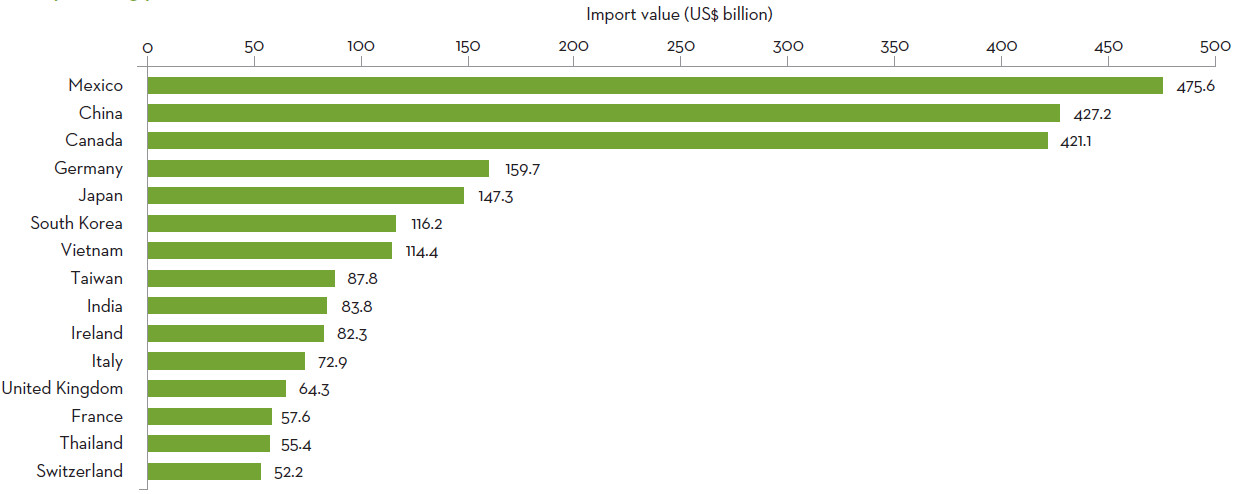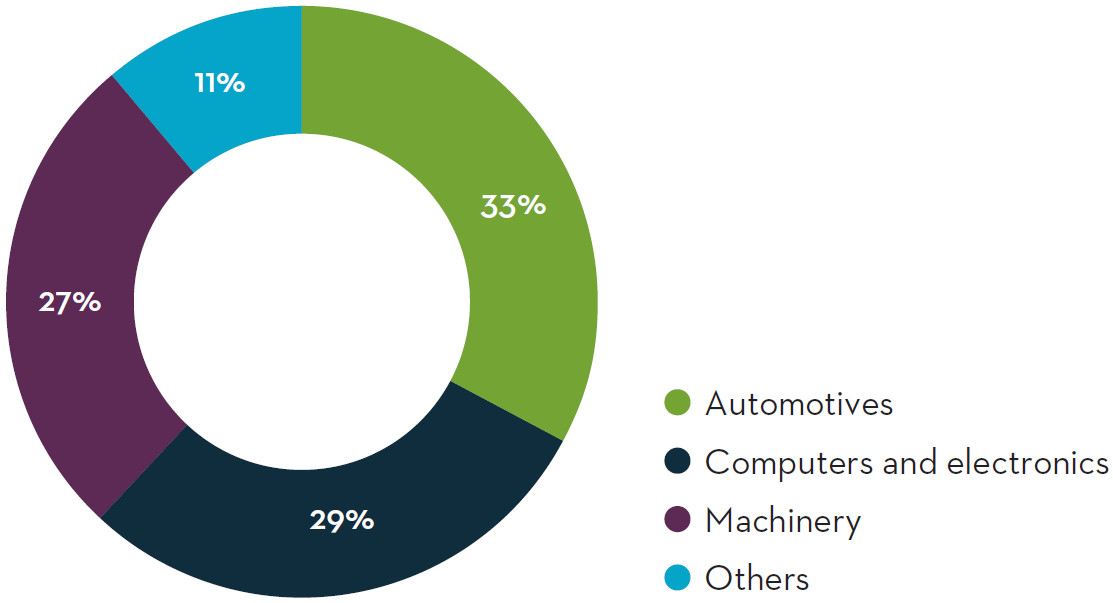Content navigation
We believe the recently announced tariffs on Canada, Mexico and China support this view. However, we caution that there is lack of clarity on final outcomes, and there is still scope for things to change substantially from here.
First of all, Mexico, China, and Canada represent the top three trading relationships between US and the Rest of the World. We believe that these tariff discussions will unwind as a series of negotiations and that the announcements in early February are a first-move in a medium-term chess game between US and its top three trading partners.
US top trading partners 2023 
Source: Statista, US Census Bureau and US Department of Commerce as at February 2024.
Specific to emerging markets (EM), both China and Mexico produce a wide range of goods that are essential to US businesses and consumers, and we think that a certain proportion of trade will continue regardless. We have already seen the impact of previous trade tariffs on China, with the country’s export numbers remaining robust despite this headwind – US exports represent less than 3% of China’s gross domestic product1.
-
We believe that these tariff discussions will unwind as a series of negotiations and that the announcements in early February are a first-move in a medium-term chess game between US and its top three trading partners.
Thoughts on Mexico
Things will be more difficult for Mexico, which sends more than three quarters of its exports to the US, although we believe this impact will be short-term and long-term solutions will be found.
Some observations regarding the shape of Mexico’s exports to the US are its significant industry concentration. Of the ~476 billion of Mexico’s exports to US - nearly 1/3 of this export value is automotives. An interesting take on this is the export mix is heavily skewed to consumer-linked industries and this could have significant impact on core consumer price index (CPI) in the US.Industry breakdown: Mexico's exports to the US
Source: Trade.gov as at 3 February 2025.
Over the last 24 months, much of the alleviation in the US Core CPI has been from goods inflation (whose contribution has been a net negative to core CPI).
However, Mexico’s equity markets have discounted this risk through the second half of 2024 with the average valuation multiple on a forward 12 month basis falling nearly 40%. MSCI Mexico is now at 10x forward earnings - nearly a 40% discount to its historical average price to earnings (P/E) ratio of 13.7x.
MSCI Mexico P/E Ratio

Source: Bloomberg as at 3 February 2025.
Process and positioning that reflects political risks
We note that markets had already started to price in negative economic scenarios after the US election and we expect share prices to continue to react on sentiment. The impact to earnings for the majority of EM listed companies should remain limited.
- Track our companies’ revenue exposure to US exports.
- Analyse each company's fundamental risks, including potential risks from geopolitics.
- Systematically assess country-specific macro and geopolitical risks.
We continue to believe that the potential of EM, and in particular listed equities, remains underappreciated and valuations do not reflect realistic long-term outcomes.
We manage our individual country risk within a tight band around the benchmark weight but over the past year our portfolio positioning has evolved to reflect changing risks.
- Our overweight to Mexico has been narrowed and we are currently benchmark neutral in Mexico.
- We have managed our active weight in larger Chinese stocks which may be exposed to potential political crosshairs.
- Further diversified of our Chinese holdings and added new stocks to the portfolio with domestic China exposure.
We continue to believe that the potential of EM, and in particular listed equities, remains underappreciated and valuations do not reflect realistic long-term outcomes.
Sources
1Source: Morgan Stanley as at 3 February 2025.
Important information
This information is issued and approved by Martin Currie Investment Management Limited (‘MCIM’), authorised and regulated by the Financial Conduct Authority. It does not constitute investment advice. Market and currency movements may cause the capital value of shares, and the income from them, to fall as well as rise and you may get back less than you invested.
The information contained in this document has been compiled with considerable care to ensure its accuracy. However, no representation or warranty, express or implied, is made to its accuracy or completeness. Martin Currie has procured any research or analysis contained in this document for its own use. It is provided to you only incidentally and any opinions expressed are subject to change without notice.
This document may not be distributed to third parties. It is confidential and intended only for the recipient. The recipient may not photocopy, transmit or otherwise share this [document], or any part of it, with any other person without the express written permission of Martin Currie Investment Management Limited.
This document is intended only for a wholesale, institutional or otherwise professional audience. Martin Currie Investment Management Limited does not intend for this document to be issued to any other audience and it should not be made available to any person who does not meet this criteria. Martin Currie accepts no responsibility for dissemination of this document to a person who does not fit this criteria.
The document does not form the basis of, nor should it be relied upon in connection with, any subsequent contract or agreement. It does not constitute, and may not be used for the purpose of, an offer or invitation to subscribe for or otherwise acquire shares in any of the products mentioned.
Past performance is not a guide to future returns.
The distribution of specific products is restricted in certain jurisdictions, investors should be aware of these restrictions before requesting further specific information.
The views expressed are opinions of the portfolio managers as of the date of this document and are subject to change based on market and other conditions and may differ from other portfolio managers or of the firm as a whole. These opinions are not intended to be a forecast of future events, research, a guarantee of future results or investment advice.
Please note the information within this report has been produced internally using unaudited data and has not been independently verified. Whilst every effort has been made to ensure its accuracy, no guarantee can be given.
Some of the information provided in this document has been compiled using data from a representative account. This account has been chosen on the basis it is an existing account managed by Martin Currie, within the strategy referred to in this document. Representative accounts for each strategy have been chosen on the basis that they are the longest running account for the strategy. This data has been provided as an illustration only, the figures should not be relied upon as an indication of future performance. The data provided for this account may be different to other accounts following the same strategy. The information should not be considered as comprehensive and additional information and disclosure should be sought.
The information provided should not be considered a recommendation to purchase or sell any particular strategy/ fund / security. It should not be assumed that any of the securities discussed here were or will prove to be profitable.
It is not known whether the stocks mentioned will feature in any future portfolios managed by Martin Currie. Any stock examples will represent a small part of a portfolio and are used purely to demonstrate our investment style.
Risk warnings – Investors should also be aware of the following risk factors which may be applicable to the strategy shown in this document.
- Investing in foreign markets introduces a risk where adverse movements in currency exchange rates could result in a decrease in the value of your investment.
- This strategy may hold a limited number of investments. If one of these investments falls in value this can have a greater impact on the strategy’s value than if it held a larger number of investments.
- Smaller companies may be riskier and their shares may be less liquid than larger companies, meaning that their share price may be more volatile.
- Emerging markets or less developed countries may face more political, economic or structural challenges than developed countries. Accordingly, investment in emerging markets is generally characterised by higher levels of risk than investment in fully developed markets.
- The strategy may invest in derivatives Index futures and FX forwards to obtain, increase or reduce exposure to underlying assets. The use of derivatives may result in greater fluctuations of returns due to the value of the derivative not moving in line with the underlying asset. Certain types of derivatives can be difficult to purchase or sell in certain market conditions.

